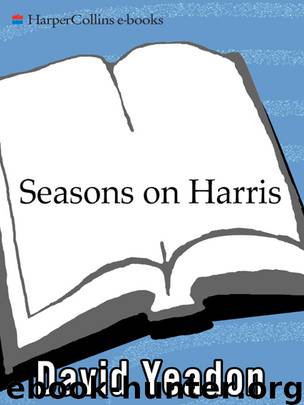Seasons on Harris by David Yeadon

Author:David Yeadon
Language: eng
Format: epub
Publisher: HarperCollins
Highland Cow
“I can’t go totally abstract,” she explained. “I’m not sure I want to. It can get far too personal—too self-focused. What I try to do is use my big black marker pens to sketch some of the basic composition lines—you know, how the massings of the boats echo the verticals of the quays, and the horizontals pick up the lines of lobster creels, the harbor wall, the decks of the trawlers. I try to find patterns—geometric forms—that work as partial abstracts of color and light but still keep the essence of the actual reality. You know, the things that made me want to sketch that particular subject in the first place…things that might make people see new beauty—awareness—in everyday scenes.”
“There seem to be touches of Cézanne…and Georges Braques in them…,” I said hesitantly. I’m always a little nervous when discussing “influences” in art. Some artists can be rather sensitive about such things.
“Oh, really—you think so?” Jane said. She giggled too, so I think she was pleased to be included in such elite company. “Thank you.”
At that point Peter interrupted our little art-soiree chat with an invitation to go see some of his projects, with a warning that “it might be a little muddy.”
Muddy it indeed was, but we soon forgot the gooey going as Peter pointed out some of the nuances of his work on the twelve-acre croft. Much of it was over our heads—references to dual-purpose cows; “natural weaning” for the calves; “maintaining family groups”; reduced castration of male sheep to increase breeding rams and the rare Hebridean stock; strict rotation schedules for potatoes, hay, and other crops on the lazybeds and higher pastures; and even the creation of a small bird-conservation area for the protection of the increasingly elusive corncrake, already nesting on Peter’s land.
It was a hard, gloppy slog up the steep slope of his croft, leaping across newly dug drainage ditches and avoiding pernicious patches of bog by hopping from tussock to tussock through the spindly marsh grass. At the high end of the croft above the Harlingtons’ home, the rough-and-tumble land began to meld with the weed-smothered remnants of old black houses. Little was left other than stumpy humps of ancient and thick stone walls, but it was obvious that over the last few centuries, a thriving crofting community had existed here.
“Some of these ruins have pre–Bronze Age origins,” said Peter. “There are burial cairns and standing stones all around here, many with cup-and-ring markings. This place has deep echoes.”
We stopped to look more closely at the rubbled remnants. A chill wind skirmished through the marsh grass, making the brittle blades rattle like old bones. Peter watched us closely and then said quietly, “Presences…can you sense them?”
Anne nodded a little warily, remembering our strange drive across the moor. I too felt that beguiling aura of layered life and death. So many centuries, so many stories, so many existences scrabbled out of this primordial, peaty earth.
“I love it up here,” Peter said quietly. “I feel we’re part of something so enduring, solid, and honest.
Download
This site does not store any files on its server. We only index and link to content provided by other sites. Please contact the content providers to delete copyright contents if any and email us, we'll remove relevant links or contents immediately.
| General | Channel Islands |
| England | Northern Ireland |
| Scotland | Wales |
Spell It Out by David Crystal(35393)
Underground: A Human History of the Worlds Beneath Our Feet by Will Hunt(11303)
A Year in the Merde by Stephen Clarke(4687)
Venice by Jan Morris(2070)
Claridge's: The Cookbook by Nail Martyn & Erickson Meredith(1982)
My Paris Kitchen: Recipes and Stories by Lebovitz David(1907)
A TIME OF GIFTS by Patrick Leigh Fermor(1863)
The Plantagenets by Dan Jones(1634)
Welcome to the Goddamn Ice Cube by Blair Braverman(1619)
Bang Poland: How To Make Love With Polish Girls In Poland by Roosh V(1609)
Top 10 Prague (EYEWITNESS TOP 10 TRAVEL GUIDES) by DK(1587)
From Russia with Lunch by David Smiedt(1563)
The Finnish Way by Katja Pantzar(1550)
The Isle of Mull by Terry Marsh(1532)
A TIME TO KEEP SILENCE by Patrick Leigh Fermor(1512)
A Taste of Paris by David Downie(1507)
Rick Steves London 2018 by Rick Steves & Gene Openshaw(1507)
Merde in Europe by Stephen Clarke(1448)
Insight Guides Experience Tokyo by Insight Guides(1431)
